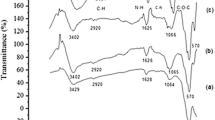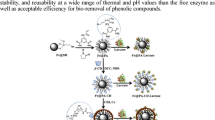Abstract
A novel and simple method was developed for the preparation of magnetic Fe3O4 nanoparticles by chemical co-precipitation method and subsequent coating with 3-aminopropyltrimethoxysilane (APTMS) through silanization process. Magnetic Fe3O4-chitosan particles were prepared by the suspension cross-linking and covalent technique to be used in the application of magnetic carrier technology. The synthesized immobilization supports were characterized by scanning electron microscopy (SEM), thermogravimetric analysis (TGA) and X-ray diffraction (XRD). Using glutaraldehyde as the coupling agent, the lipase from R. oryzae was successfully immobilized onto the functionalized magnetic Fe3O4-chitosan beads. The results showed that 86.60% of R. oryzae lipase was bound on the synthesized immobilization support. This immobilized lipase was successfully used for the esterification of phenolic acid which resulted in esterification of phenolic acid in isooctane solvent reaction system for 8 consecutive cycles (totally 384 h), 72.6% of its initial activity was retained, indicating a high stability in pharmaceutical and industrial applications.
Similar content being viewed by others
References
Gandhi, N. N. (1997) Applications of lipase. J. Am. Oil. Chem. Soc. 74: 621–634.
Fernandez-Lafuente, R. (2010) Lipase from Thermomyces lanuginosus: Uses and prospects as an industrial biocatalyst. J. Mol. Catal. B-Enzym. 62: 197–212.
Pandey, A., S. Benjamin, C. R. Soccol, P. N. Krieger, and V. T. Soccol (1999) The realm of microbial lipases in biotechnology. Biotechnol. Appl. Biochem. 29: 119–131.
Chang, S. W., J. F. Shaw, K. H. Yang, S. F. Chang, and C. J. Shieh (2008) Studies of optimum conditions for covalent immobilization of Candida rugosa lipase on poly (gamma-glutamic acid) by RSM. Bioresour. Technol. 99: 2800–2805.
Wu, Y., Y. J. Wang, G. S. Luo, and Y. Y. Dai (2008) In situ preparation of magnetic Fe3O4-chitosan nanoparticles for lipase immobilization by cross-linking and oxidation in aqueous solution. Bioresour. Technol. 100: 3459–3464.
De-Sheng, J., Y. L. Sheng, J. Huang, X. Hai-Yan, and Z. Ju-Ying (2005) Immobilization of Pycnoporus sanguineus laccase on magnetic chitosan microspheres. Biochem. Eng. J. 25: 15–23.
Tang, Z. X., J. Q. Qian, and L. E. Shi (2006) Characterizations of immobilized neutral proteinase on chitosan nano-particles. Proc. Biochem. 41: 1193–1197.
Li, G. Y., Z. D. Zhou, Y. J. Li, K. L. Huang, and M. Zhong (2010) Surface functionalization of chitosan-coated magnetic nanoparticles for covalent immobilization of yeast alcohol dehydrogenase from Saccharomyces cerevisiae. J. Magn. Mater. 322: 3862–3868.
Liu, Y., S. Jia, J. Ran, and S. Wu (2010) Effects of static magnetic field on activity and stability of immobilized α-amylase in chitosan bead. Catal. Commun. 11: 364–367.
Shakeel, A. A. and Q. Husain (2012) Potential application of enzymes immobilized on/in nano material: A review. Biotechnol. Adv. 30: 512–523.
Zhang, S. and S. Gao (2010) Immobilization of β galactosidase onto magnetic beads. Appl. Biochem. Biotechnol. 160: 1386–1393.
Chiou, S. and H. W. T. Wu (2004) Immobilization of Candida rugosa lipase on chitosan with activation of the hydroxyl groups. Biomat. 25: 197–204.
Moore, D. and R. Reynolds (1997) X-Ray Diffraction and the Identification and Analysis of Clay Minerals. pp. 270–276. Oxford University Press, NY, USA.
Nelson, L. A., T. A. Foglia, and W. N. Marmer (1996) Lipasecatalyzed production of biodiesel. J. Am. Oil Chem. Soc. 73: 1191–1195.
Reetz, M. T., A. Zonta, V. Vijayakrishnan, and K. Schimossek (1998) Entrapment of lipases in hydrophobic magnetite-containing sol-gel materials: Magnetic separation of heterogeneous biocatalysts. J. Mol. Catal. A: Chemical. 134: 251–258.
Compton, D. L. (2005) Sunscreens based on vegetable oil. Lipid Technol. 17: 276–279.
Saija, A., A. Tomaino, R. L. Cascio, D. Trombetta, A. Proteggente, A. D. Pasquale, N. Uccella, and F. Bonina (1999) Ferulic and caffeic acids as potential protective agents against photooxidative skin damage. J. Sci. Food Agric. 79: 476–480.
Murakami, A., Y. Nakamura, K. Koichi, D. Koshimizu, K. Takahashi, K. Matsumoto, K. Hagihara, H. Taniguchi, E. Nomura, A. Hosoda, T. Tsuno, H. W. Maruta, K. Kim, K. Kawabata, and H. Ohigashi (2002) A hydrophobic derivative of ferulic acid, suppresses inflammatory responses and skin tumor promotion: Comparison with ferulic acid. Cancer Lett. 180: 121–129.
Tsuchiyama. M., T. Sakamoto, T. Fujita, S. Murata, and S. Kawasaki (2006) Esterification of ferulic acid with polyols using a ferulic acid esterase from Aspergillus niger. Biochim. Biophys. Acta Gen. Subj. 1760: 1071–1079.
Chalas, J., C. Claise, M. Edeas, C. Messaoudi, L. Vergnes, A. Abella, and A. Lindenbaum (2001) Effect of ethyl esterification of phenolic acids on low-density lipoprotein oxidation. Biomed. Pharmacother. 55: 54–60.
Dung, D. T. K., T. H. Hai, L. Phuc, H. B. Long, D. L. K. Vinh, and P. N. Truc (2009) Preparation and characterization of magnetic nanoparticles with chitosan coating. J. Phys. Conf. Ser. 187: 012036.
Lee, D. H., C. H. Park, J. M. Yeo, and S. W. Kim (2006) Lipase immobilization on silica gel using a cross-linking method. J. Ind. Eng. Chem. 12: 777–782.
Guibal, E., M. Jansson-Charrier, I. Saucedo, and P. L. Cloirec (1995) Enhancement of metal ion sorption performances of chitosan: Effect of the structure on the diffusion properties. Langmuir. 11: 591–598.
Winkler, U. K. and M. Stuckmann (1979) Glycogen, hyaluronidate and some other polysaccharides greatly enhance the formation of exocellular lipase by Serratia marcescens. J. Bacteriol. 138: 663–670.
Ye, P. Z., K. Xu, Z. G. Wang, J. Wu, H. T. Deng, and P. Seta (2005) Comparison of hydrolytic activities in aqueous and organic media for lipases immobilized on poly(acrylonitrile-comaleic acid) ultrafiltration hollow fiber membrane. J. Mol. Catal. B: Enz. 32: 115–121.
Miletic, N., A. Volker, E. Katrin, and L. Katja (2010) Immobilization of Candida antarctica lipase B on polystyrene nanoparticles. Macromol. Rapid Commun. 31: 71–74.
Aravind, S., J. K. Stephen, I. Patrick, O. K. B. Jacobson, W. Jonathan, and J. D. Michel (1999) Comparison of techniques for enzyme immobilization on silicon supports. Enz. Microb. Tech. 24: 26–34.
Tang, T., H. Fan, S. Ai, R. Han, and Y. Qiu (2011) Hemoglobin (Hb) immobilized on amino-modified magnetic nanoparticles for the catalytic removal of bisphenol A. Chemosphere. 83: 255–264.
Denkbas, E. B., E. Kilicay, C. Birlikseven, and F. E. Ozturk (2002) Magnetic chitosan microspheres: Preparation and characterization. React. Funct. Polym. 50: 225–232.
Lopez-Gallego, F., L. Betancor, C. Mateo, A. Hidalgo, N. Alonso-Morales, and G. Dellamora-Ortiz (2005) Enzyme stabilization by glutaraldehyde crosslinking of adsorbed proteins on aminated supports. J. Biotechnol. 119: 70–75.
Bin, H., P. Jiang, Y. Hui-Lei, L. Jian-Wen, and X. Jian-He (2009) Immobilization of Serratia marcescens lipase onto amino-functionalized magnetic nanoparticles for repeated use in enzymatic synthesis of diltiazem intermediate. Proc. Biochem. 44: 1019–1024.
Kumar, A. and S. S. Kanwar (2011) Synthesis of ethyl ferulate in organic medium using celite-immobilized lipase. Bioresour. Technol. 102: 2162–2167.
Demira, A. S., F. N. Talpura, S. B. Sopacia, G. -W. Kohring, and A. Celik (2011) Selective oxidation and reduction reactions with cofactor regeneration mediated by galactitol-, lactate- and formate dehydrogenases immobilized on magnetic nanoparticles. J. Biotechnol. 152: 176–183.
Author information
Authors and Affiliations
Corresponding author
Rights and permissions
About this article
Cite this article
Kumar, V., Jahan, F., Raghuwanshi, S. et al. Immobilization of Rhizopus oryzae lipase on magnetic Fe3O4-chitosan beads and its potential in phenolic acids ester synthesis. Biotechnol Bioproc E 18, 787–795 (2013). https://doi.org/10.1007/s12257-012-0793-8
Received:
Revised:
Accepted:
Published:
Issue Date:
DOI: https://doi.org/10.1007/s12257-012-0793-8




